Motherboard Layout

The MSI MEG X570 GODLIKE is a full-sized E-ATX motherboard. It’s PCB is very crowded due to the sheer volume of stuff integrated into its design. Not only that, but it features many extras which are hardly necessary, but are there to help convey that premium hardware experience. That said, the layout is still rather exceptional in spite of the volume of hardware integrated into the thing.
The motherboard features an 8-layer PCB and a beefy 14+4 phase VRM. On the PCB you’ll find 9x 4-pin fan headers, one of which is a dedicated water-pump header, and another is for the CPU fan. You will also find two 2-pin thermistor cable headers and 1x 3 pin water flow sensor. Of course, this is the era of rainbow vomit……..er RGB LED’s so you will find a plethora of RGB headers supporting various standards. This includes a standard 4-pin RGB header, 2x 3-pin RAINBOW LED connectors and 1x 3-pin Corsair LED header.
In truth, part of this motherboards appeal is the fact that it’s over the top and insane. One of the biggest reasons to buy a motherboard like this comes down to being able to make it a showpiece. It’s the center of your computer’s performance and it’s among the most visible components in any case with a window in the side. As with most things on this motherboard, it sets a new bar for options. I’ve never seen so many RGB options on a single motherboard.
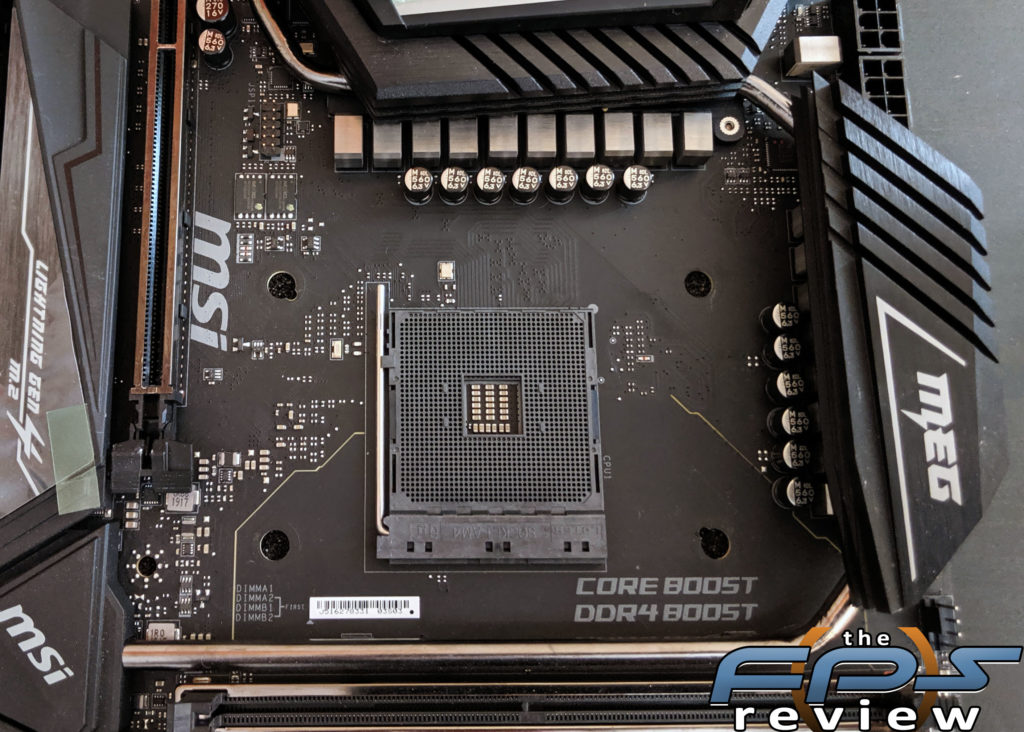
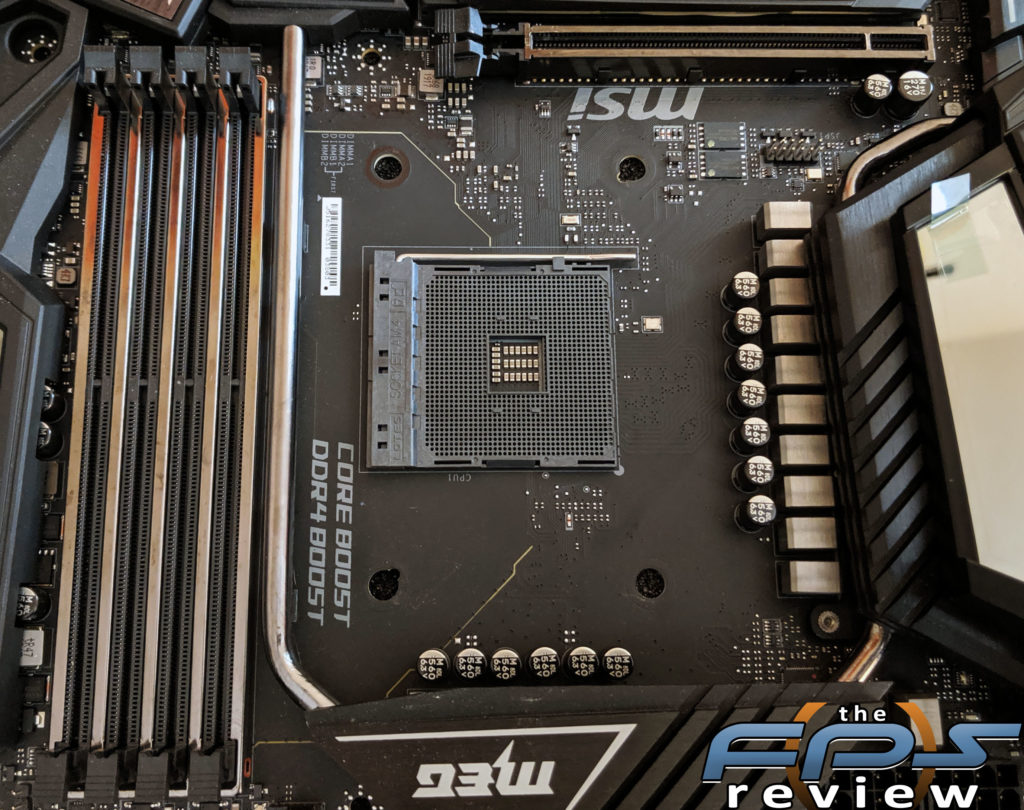
CPU Socket and VRM
The CPU socket area is relatively free of obstructions. Cooling our MOSFETs are some very large, but unobtrusive heat sinks which are very well made with am embedded heat pipe. This heat pipe connects both the CPU vCore and SOC phase MOSFET coolers with the PCH (chipset) heat sink. This is something we used to see a few years ago, but, hasn’t been necessary for a while. This is due to the fact that modern multi-core CPUs are more demanding power-wise which necessitates the more extreme VRM cooling. The connected chipset cooling is bordering on necessary as the X570 chipset is a 15W TDP part instead of the 6 Watts we saw with X470.
MSI chose to use a 14+4 phase VRM design. 14 phases are used for CPU vCore and 4 phases are used for SOC voltage. MSI uses an IR35201 voltage controller, The IR35201 is an 8-phase controller in a 7+1 configuration. This means that our 14+4 phase VRM is using doublers to achieve the higher phase count. Specifically, the SoC uses an IR3599 in quadruple mode to get its phase count.
This is a perfectly normal and valid approach to the design, but MSI isn’t doing anything revolutionary here. There are newer and more advanced designs out there, but the power delivery the MSI MEG X570 GODLIKE is capable of delivering is far in excess of what you would need for cooling any AM4 CPU, even under liquid nitrogen. As far as hardware is concerned, the MSI MEG X570 GODLIKE shouldn’t ever be a limiting factor regarding Ryzen overclocking.
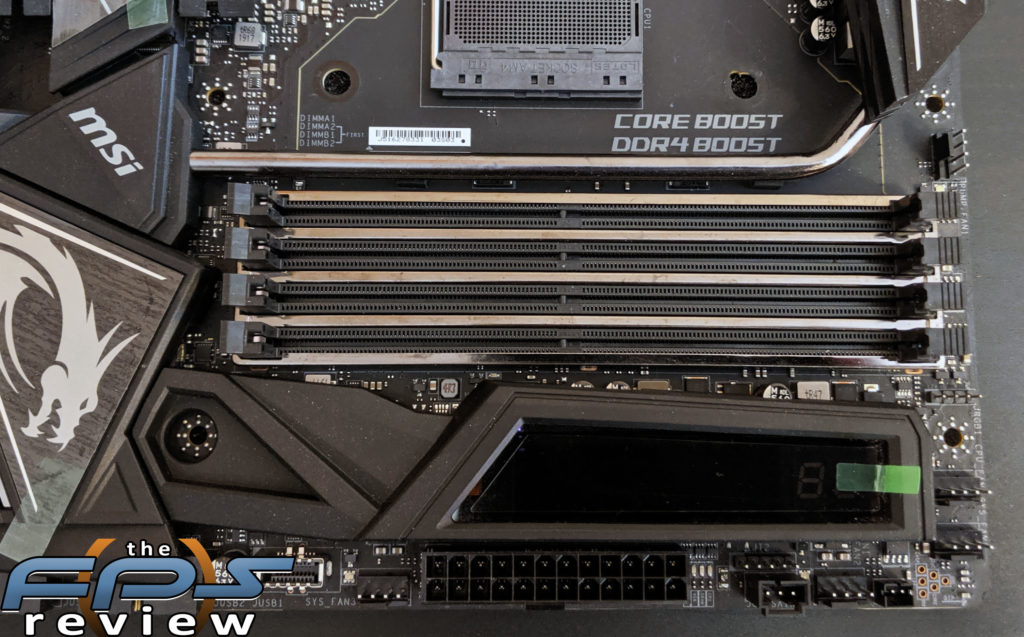
Steel Reinforced
There are four steel-reinforced 288-pin DDR4 memory slots that utilize single-sided locking tabs for memory retention. The slots are not color-coded to denote proper dual channel memory mode operation. This was obviously done for aesthetic reasons. The slots support memory speeds up to DDR4 4800MHz through overclocking and memory modules totaling 128GB.
In front of the DDR4 DIMM slots, you’ll find an LCD display and the 24 pin ATX power connector. There are also several headers for RGB and fans in this area as well.

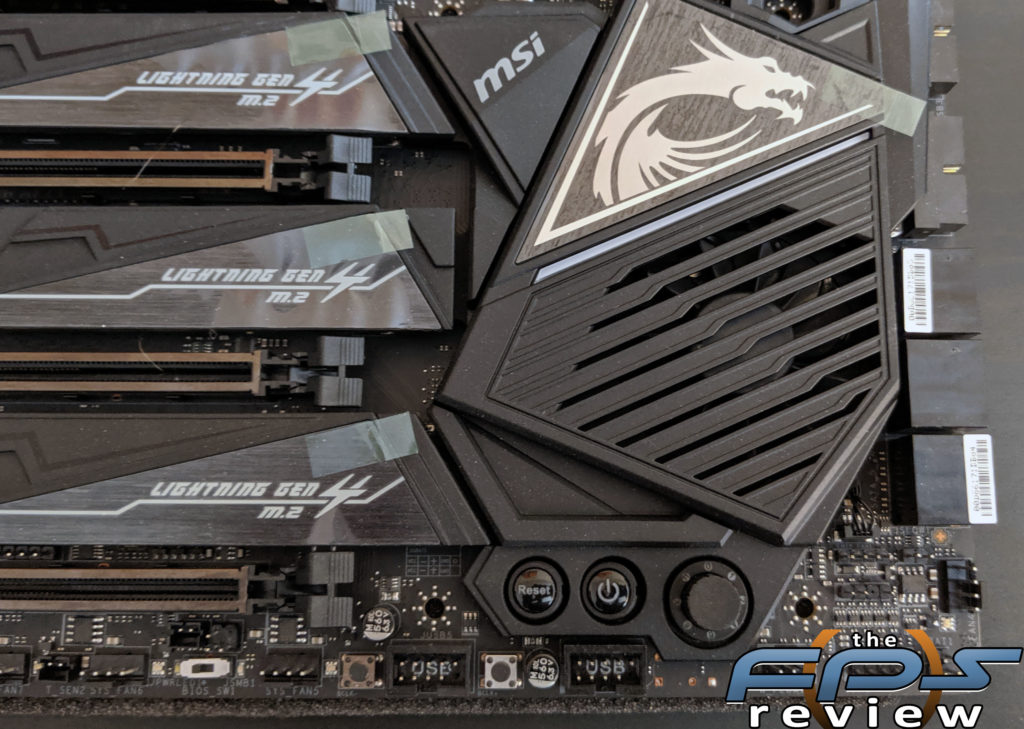
Chipset
The chipset is cooled by an active heat sink and fan. This heat sink also has an embedded heat pipe, which connects to the MOSFET coolers near the CPU socket. You can actually see the heat pipe running along the backside of the first DIMM slot and around the outer edge of the motherboard. The heat sink has a shroud around it which features power, reset, and overclocking controls.
Despite the nature of the motherboard, the overclocking knob feels relatively low rent. It’s the only part of the motherboard that does. In this area, you will also find bclk adjustment buttons to increment the base clock up or down in small increments. Among the controls available is a switch to toggle between both BIOS ROMs. You will also find the water flow sensor down here as well as some more RGB connectivity options.
On the subject of the chipset fan, literally, no one was looking forward to seeing these things reappear again. When the system powers on, the chipset fan is very noisy. After the system gets past POST, the chipset fan speed drops to an inaudible level. On the test bench, the fan never reached noise levels that concern me, although, I will say that this was on an open test bench, so your mileage may certainly vary.
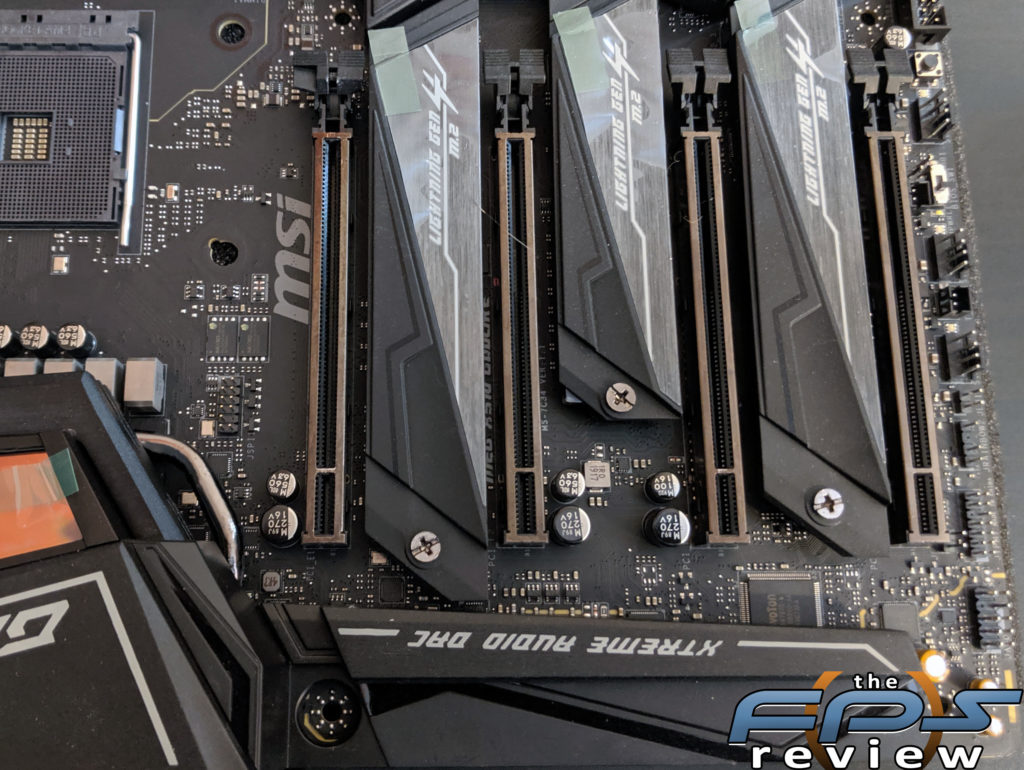
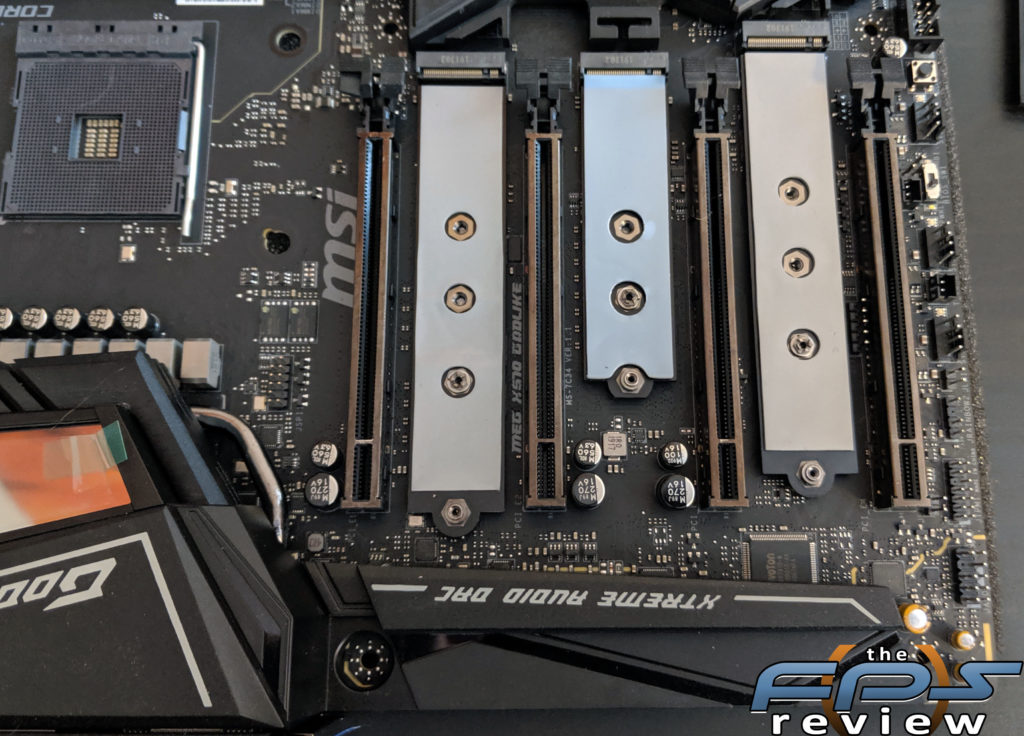

Expansion
The expansion slot area is as close to perfect as I think you can truly get. Gone are the days of 7 full expansion slots, or are they? In between each traditional PCIe x16 form factor slot is an M.2 slot. These are essentially PCIe slots that happen to be in a smaller form factor that is dedicated to storage. The PCIe slots are all Gen 4.0 compliant and are steel reinforced. Not only does this provide added durability but also makes for a nice aesthetic.
The MSI MEG X570 GODLIKE supports the following PCIe lane configurations for its expansion slots: x16/x0/x0, x8/x0/x8 or x8/x4/x4. Lastly, there is a single PCIe 4.0 x16 form factor slot supporting 4x PCIe lanes attached to the PCH rather than the CPU.
The M.2 slots are spaced nicely, but unfortunately, the primary M.2 slot places an M.2 drive underneath the GPU. While less than ideal, this has never been problematic in my testing. Naturally, on the test bench, this shouldn’t ever be an issue, but it has been my experience with built systems using full chassis as well. The heat sink covers feel very high quality. They have a nice molded clip at the end which allows them to stay secure at the front of the slot. They rotate up and off the motherboard.
The screws that secure these in place are captive, which is a very nice touch. These are also slightly larger which allows the use of at least a #2 Phillips head screwdriver. Once the covers are out of the way, you’ll find multiple mounting options based on the length of the drive your installing. You will also find a thermal pad on the bottom of the slot as well as the top cover, which acts as a heat sink. The Corsair MP600 used in our testing comes with its own heat sink, so it is fair to say that these drives can get hot. However, I only used the included MSI heat sink and never had any trouble. Performance data looked good, indicating that there isn’t any throttling occurring here.

I/O
The MSI MEG X570 GODLIKE comes with a built-in I/O shield. On the back panel, you will find a standard PS/2 keyboard or mouse port, 2x wireless antenna connections, clear CMOS and BIOS flash buttons, 2x RJ-45 LAN ports, 4x USB 3.1 Gen 2 ports, (3x Type-A, 1x Type-C), 1x 6.3mm headphone jack, 5x mini-stereo jacks and 1x optical out, Ports are clearly marked and have good contrast in reasonably good lighting.
